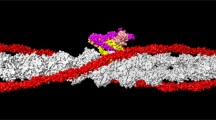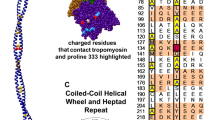Abstract
There is a growing awareness of the role of tropomyosin in the regulation of the actin filament. Work in the field is increasingly directed at understanding the mechanisms of function at both a molecular and atomic level and developing therapeutic strategies to treat tropomyosin-based pathology. This chapter highlights unresolved issues that cross the boundaries between individual chapters and are likely to be fertile areas of research in the future.
Access this chapter
Tax calculation will be finalised at checkout
Purchases are for personal use only
Preview
Unable to display preview. Download preview PDF.
Similar content being viewed by others
References
Alberts B, Bray D, Lewis J et al. Molecular Biology of the Cell, 3rd Ed. Garland Publishing Inc., New York: 1994; Fig 16–79.
Ayscough KR. In vivo functions of actin-binding proteins. Curr Opin Cell Biol 1998; 10:102–111.
Craig SW, Pardo JV. Gamma actin, spectrin and intermediate filament proteins colocalize with vinculin at costameres, myofibril-to-sarcolemma attachment sites. Cell Motil 1983; 3:449–462.
Kee AJ, Schevzov G, Nair-Shalliker V et al. Sorting of a nonmuscle tropomyosin to a novel cytoskeletal compartment in skeletal muscle results in muscular dystrophy. J Cell Biol 2004; 166:685–696.
Lubit BW. Association of beta-cytoplasmic actin with high concentrations of acetylcholine receptor (AChR) in normal and anti-AChR-treated primary rat muscle cultures. J Histochem Cytochem 1984; 32:973–981.
Schevzov G, Lloyd C, Hailstones D et al. Differential regulation of tropomyosin isoform organisation and gene expression in response to altered actin gene expression. J Cell Biol 1993; 121:811–821.
Wong K, Wessels D, Krob SL et al. Forced expression of a dominant-negative chimeric tropomyosin causes abnormal motile behaviour during cell division. Cell Motil Cytoskel 2000; 45:121–132.
Vlahovich N, Schevzov G, Nair-Shalliker V et al. Tropomyosin 4 defines novel filaments in skeletal muscle associated with muscle remodelling/regeneration in normal and disease muscle. Cell Motil Cytoskel 2008; 65:73–85.
Houle F, Rousseau S, Morrice N et al. Extracellular signal-regulated kinase mediates phosporylation of tropomyosin-1 to promote cytoskeleton remodelling in response to oxidative stress: impact on membrane blebbing. Mol Biol Cell 2003; 14:1418–1432.
Naga Prasad SV, Jayatilleke A, Madamanchi A et al. Protein kinase activity of phosphoinositide 3-kinase regulates beta-adrenergic receptor endocytosis. Nat Cell Biol 2005; 7:785–796.
Somara S, Pang H, Bitar KN. Agonist-induced association of tropomyosin with the protein kinase C-α in colonic smooth muscle. Am J Physiol Gastrointest Liver Physiol 2005; 288:G268–G276.
Gunning P, O’Neill G, Hardeman E. Tropomyosin-based regulation of the actin cytoskeleton in time and space. Physiol Rev 2008; 88:1–35.
Lehman W, Hatch V, Korman V et al. Tropomyosin and actin isoforms modulate the localization of tropomyosin strands on actin filaments. J Mol Biol 2000; 302:593–606.
Prasad GL, Fuldner RA, Cooper HL. Expression of transduced tropomyosin 1 cDNA suppresses neoplastic growth of cells transformed by the ras oncogene. Proc Natl Acad Sci USA 1993; 90:7039–7043.
Boyd J, Risinger JI, Wiseman RW et al. Regulation of microfilament organization and anchorage-independent growth by tropomyosin1. Proc Natl Acad Sci USA 1995; 92:11534–11538.
Gimona M, Kazzaz JA, Helfman DM. Forced expression of tropomyosin 2 or 3 in v-ki-ras-transformed fibroblasts results in distinct phenotypic effects. Proc Natl Acad Sci USA 1996; 93:9618–9623.
O’Neill GM, Stehn J, Gunning PW. Tropomyosins as interpreters of the signalling environment to regulate the local cytoskeleton. Seminars Cancer Biol 2008; 18:35–44.
Author information
Authors and Affiliations
Editor information
Editors and Affiliations
Rights and permissions
Copyright information
© 2008 Landes Bioscience and Springer Science+Business Media
About this chapter
Cite this chapter
Gunning, P. (2008). Emerging Issues for Tropomyosin Structure, Regulation, Function and Pathology. In: Gunning, P. (eds) Tropomyosin. Advances in Experimental Medicine and Biology, vol 644. Springer, New York, NY. https://doi.org/10.1007/978-0-387-85766-4_22
Download citation
DOI: https://doi.org/10.1007/978-0-387-85766-4_22
Publisher Name: Springer, New York, NY
Print ISBN: 978-0-387-85765-7
Online ISBN: 978-0-387-85766-4
eBook Packages: Biomedical and Life SciencesBiomedical and Life Sciences (R0)




